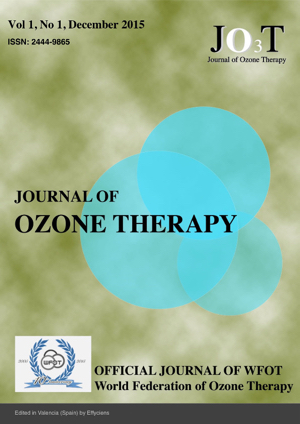Efficacy of OLEOZON® compared to Alvogil in the treatment of alveolitis.
DOI:
https://doi.org/10.7203/jo3t.1.1.2015.12162Keywords:
alveolitis treatment, Alvogil, OLEOZON®, ozonated vegetable oils efficacy Abstract
Abstract
Alveolitis is a reversible infection of alveolar process after tooth extraction. Its etiology is unknown, but there are factors increasing its incidence such as traumatisms, infections, decrease of vascular supply of surrounding bone and general systemic status. Aimed at comparing the efficacy of OLEOZON® (ozonated sunflower oil) with Alvogil, treating alveolitis clinically and microbiologically and determining the degree of patients´ satisfaction and side effects. A controlled, randomized, single.blind, phase III clinical trial was conducted at “Reynold García” Polyclinic, Matanzas municipality (Cuba), between January 2007 and May 2010. The sample included 100 adult patients, aging from 20 to 59 years, with diagnostic criterion of alveolitis; 50 patients in the experimental group, to which were applied OLEOZON® and in the other 50 patients, Alvogil, a conventionally used medication of well-known efficacy. Cures were made every 72 hours as well as many visits as necessary to the dentist’s office. Healing criterion was formation of granulation tissue and pain relief. Patients were recovered with OLEOZON® by 92% and with Alvogil, by 78%, in the third visit, with significant differences between both groups. The majority of patients needed from 2 to 3 visits to the dentist’s office in both groups, though it was observed that there was a greater number of patients recovered in the group treated with OLEOZON® in the second visit, with significant differences regarding the control group. OLEOZON® proved better efficacy than Alvogil. No side effects against the medication under study were observed.
 Downloads
Downloads
 References
References
Colectivo-de-autores . Programa Nacional de Atencion Estomatologica Integral a la Poblacion. La Habana, Cuba: MINSAP. ECIMED; 2011.
Camino-Junior R, Luz-de-Cerqueira JG. Alveolite: prevençao e principios de tratamento. J Bras Clin Odontol Integr. 2003;7(39):228-232.
Mariano RC, de-Almeida SR, Feltran-do-Prado K. Estudo comparativo entre duas formas de tratamento de alveolite: rifamicina em pasta e líquida. Rev Paul Odontol. 2003;25(6):10-14.
Muiño JC, Garnero R, Bois RC, Gregorio MJ, Ferreto M, Romero-Piffiguer M. Estudio de la respuesta inflamatoria celular a traves del lavado bronco alveolar en asma alergica, por aspirina y en las alveolitis alergica extrinseca. Rev Fac Cienc Med Cordoba. 2003;59(1):71-82.
Horta-Muñoz DM, Rodriguez-Mora MM, Lopez-Govea F, Herrera-Miranda GL, Coste-Reyes J. La diabetes mellitus como factor de riesgo de perdida dentaria en la poblacion geriátrica/Diabetes Mellitus as a risk factor for loss of teeth in geriatric population. Rev Ciencias Medicas. 2010;14(1):17-25.
Martínez-de-Santelices AR, Gonzalez-Gonzalez F, Nicolau O, Suarez-Sori B. Manifestaciones orales en portadores de diabetes Mellitus tipo 2 de reciente diagnostico. AMC. 2010;14(1).
Sanz-Sanchez I, Bascones-Martínez A. Diabetes mellitus: Su implicacion en la patologia oral y periodontal/ Diabetes: oral and periodontal implications. Av Odontoestomatol. 2009;25(5):249-263.
Newsholme P, Haber EP, Hirabara SM, Rebelato EL, Procopio J, Morgan D, et al. Diabetes associated cell stress and dysfunction: role of mitochondrial and non-mitochondrial ROS production and activity. J. Physiol. 2007;583:9-24.
Fahmy,Z . The applications of Ozone Therapy in pain Management, Rheumatic and orthopaedic diseases. Germany: ODREI Pub; 2008.
Díaz M, Hernandez R, Martínez G, Vidal G, Gomez M, Fernandez H, et al. Comparative Study of Ozonized Olive Oil and Ozonized Sunflower Oil. Journal of the Brazilian Chemical Society. 2006;17(2):403-407.
Contreras R, Gomez M, Menendez S. Efecto de la sustitucion del aceite de oliva por aceite de girasol, sobre la actividad antimicrobiana del aceite ozonizado. Revista CENIC Ciencias Quimicas. 1989;20(1-3):121.
Sechi LA, Lezcano I, Nuñez N, Espim M, Dupre I, Pinna A. Antibacterial Activity of Ozonized Sunflower Oil (OLEOZON). J. Appl. Microbiol. 2001;90(2):279.
Viebahn-Hansler R. The use of ozone in medicine. 5th ed. Iffezheim, Germany: ODREI publisher; 2007.
Martinez G, Merino N, Sam S, Cenarega T. Efecto histologico y bioquímico del Oleozon en el modelo de la cola de raton. Rev CENIC Ciencias Biologicas. 1997;28(1):31-35.
Martinez G, Leon OS, Rodriguez C, Merino N. Estudio de la toxicidad aguda dermica del aceite ozonizado “Oleozon” en ratas. Rev CENIC Ciencias Biologicas. 1997;28(1):35-47.
Guanche D. Effect of ozone/oxygen mixture on systemic oxidative stress and organic damage. Toxicology Mechanisms and Methods. 2010;20(1):25-30.
Guanche D, Hernandez F, Zamora Z, Alonso Y. Effect of ozone pre-conditioning on redox activity in a rat model of septic shock. Toxicology Mechanisms and Methods. 2010;20(8):466-471.
Martinez-Abreu J Chapelin-Arencibia Y, , Peña-Ruiz T. Oleozon en el tratamiento de la gingivitis cronica edematosa. Rev Med Electron. 2006;28(6). Available from: http://www.cpimtz.sld.cu/revista%20medica/ano%202006/vol6%202006/tema05.htm
Perez-Barrero BR, Rodriguez MG, Paneque-Gamboa MR, , Perez-Castro A. La ozonoterapia en estomatologia / Ozonotherapy in Stomatology. Medisan. 2009;13(4).
Cruz-Guerra O, Menendez-Cepero S, Martinez-Jordan ME, Clavera-Vazquez T. Aplicacion de la ozonoterapia en el tratamiento de la alveolitis / Application of ozonotherapy in the treatment of alveolitis. Rev Cubana Estomatol. 1997;34(1):21-24.
Martinez-Abreu J. Abreu-Sardiñas, M. Oleozon en el tratamiento de la periodontitis simple moderada. Rev Med Electron. 2005;27(3). Available from: http://www.cpimtz.sld.cu/revista%20medica/ano%202005/vol6%202003/tema05.htm
Published
How to Cite
-
Abstract987
-
PDF591
-
HTML1384
Issue
Section
License
Journal of Ozone Therapy applies the Creative Commons Attribution-NonCommercial 4.0 International License (CC BY NC 4.0) license to works we publish.
Under this license, authors retain ownership of the copyright for their content, but allow anyone to download, reuse, reprint, modify, distribute and/or copy the content as long as the original authors and source are cited. No permission is required from the authors or the publishers.
You may not use the material for commercial purposes.
Appropriate attribution can be provided by simply citing the original article, provide a link to the license, and indicate if changes were made.
You may do so in any reasonable manner, but not in any way that suggests the licensor endorses you or your use.




